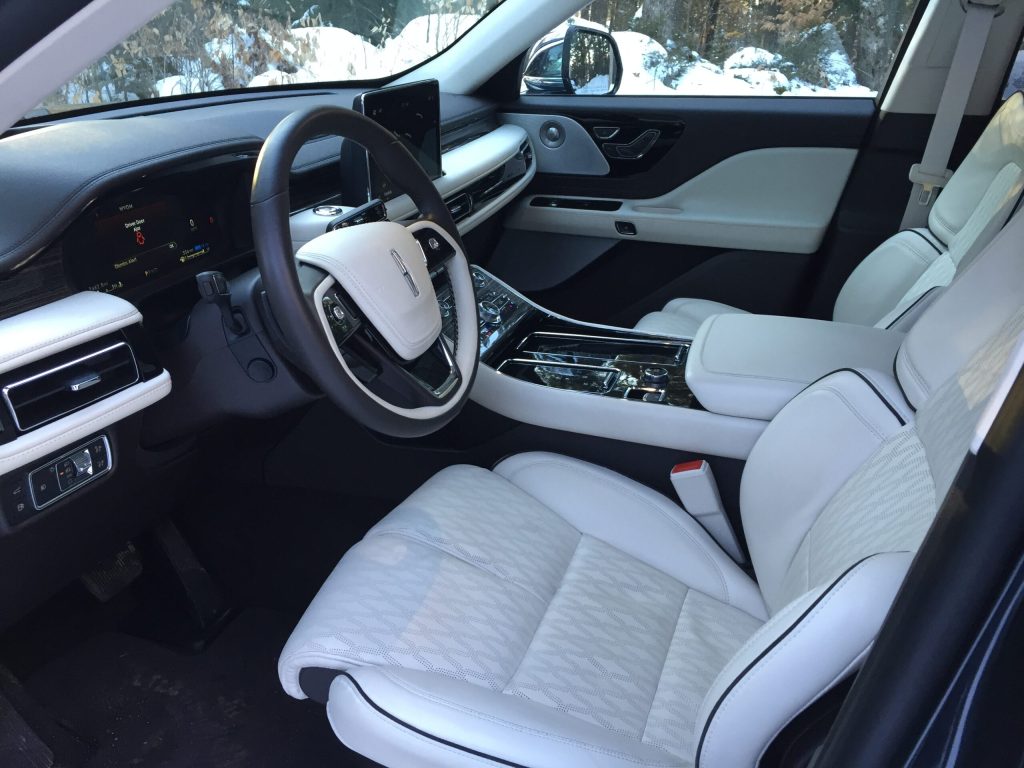Anyone who has spent any time in a Boston region rush hour soon understands why Massachusetts drivers are so aggressive —you would never get anywhere otherwise. The time commitment is also why today’s luxury cars have interiors stocked with the latest creature features and entertainment options. You get to savor all of this leather and hardware everyday, as you sit, and sit, and…
The Lincoln Aviator—a full-size six or seven passenger crossover based on the latest rear-drive oriented Ford Explorer re-design, sampled here in top Grand Touring trim with hybrid-drive—takes big strides in an attempt to isolate buyers from the vulgarities of these persistent traffic jams, while providing a sumptuous interior that massages, coddles and otherwise pleases its occupants.
As sleek and handsome outside as the interior is calming and prestigious inside, the Aviator slips into Lincoln’s expanding SUV lineup just under the Navigator, but ahead of the Nautilus 2-row crossover and the new compact Corsair. Thank you, Lincoln, for returning to proper car names. Your rising market share can be attributed to consumers now knowing what your products are, as well as because they are vastly more desirable than your former cars.
Replacing the outgoing MKT—which was based on the Ford Flex, and filled the role of the corporate livery vehicle since the departure of the Town Car decades ago—the Aviator is loaded with style. It is also well-equipped, available with rear or all-wheel drive, plus it features two new engines. The “stock” motor is a twin-turbo Ecoboost 3.0-liter V-6 making a stout 400-hp, while the hybrid trim adds a 13.6kW lithium ion battery pack and electric motor to send a peak 494-hp and 630-lb/ft of torque to the wheels. This is big power, and creates impressive speed, however, tipping the scales at over 5,400 pounds forces the sweet 10-speed automatic to work overtime attempting to blunt the physics of excessive mass.
The central reason to buy a hybrid is fuel economy, which here achieves 18-miles of electric only driving when you plug-in overnight—rises to 27-mpg when driven at the EPA tested 60-mph highway pace, three miles per gallon over the non-hybrid model. Actual mileage hovered around 22-23-mpg.
Most captivating about the Aviator will be the comfort inside. The 30-way massaging seats—heated and cooled, plus the dual panel sunroof, side window shades, massive consoles front and rear, as well as a concert-quality, 28-speaker, Revel audio system will make every trip special—even those elongated journeys into your local metro-region. The 12-inch touch screen is user friendly, while the adaptive steering and Dynamic Handling air glide suspension—sensors read the road ahead and automatically alter chassis settings to smooth the ride—will create instant envy among your non-Aviator friends.
There are contrasts. The shifter is a series of piano-keys on the dash which could respond faster. The nav screen is huge and easy to use, yet missed a couple of addresses. While the electric-pressure switch door handles are clever, they did not work well coated with freezing moisture. Hushed down the road, the Aviator’s operating pedals lacked the tactile feedback that some sporting drivers might prefer (after all, there is a driving mode selector) and that console sometimes felt like your favorite dog crowding you on the couch—it’s just too wide, mimicking the large rear-drive floor tunnel underneath. Your smartphone can be your key, the big wagon can park itself, plus a full array of driving assists will help you arrive stress-free.
Aviator rivals include Cadillac’s new XT6 and Audi Q7, the older Volvo XC90 and Infiniti Q60, plus the Lincoln is dangerously close in size to both the remodeled Escalade and the existing Mercedes GLS—both of which have slightly better driving dynamics as well as more room and more towing capacity. Aviator pricing starts at $52,195, climbing to the far side of $70,000 when fully optioned.
But none of these rival three-row wagons has the cache found inside the Aviator. The textures and complimentary wood, leather, and metal surfaces are richly pieced together to provide optimum traveling pleasure—and then you activate the massaging seats. Eight lanes of stopped traffic. What traffic?
Lincoln and cross-town rival Cadillac have finally rolled out the crossovers and SUVs that the market is demanding, after forcing competent, if not sought after, sedans and coupes into showrooms. American drivers like their trucks and utility vehicles, and rides like the latest Aviator should power Lincoln back to relevance.
Send questions/comments to the editors.





Comments are no longer available on this story